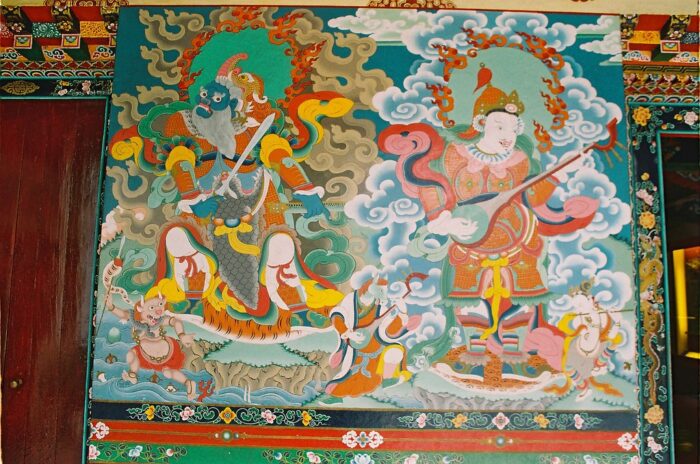A Thangka painting (alternatively spelt as hangka, tangka, thanka, or tanka) is a Tibetan Buddhist painting on cotton, silk applique that usually depicts a Buddhist deity or mythological scenes
Thangka serve as important teaching tools depicting the life of the Buddha, various influential lamas and other deities and bodhisattvas
This article will give details about Thangka painting within the context of the Art and Culture segment of the Civil Services Examination
History of Thangka Paintings
Tibetan Buddhist paintings have their origins in early Buddhist paintings that today survive in a few places like the Ajanta Caves and the Mogao Caves in China. These cave paintings are repositories for early Tibetan paintings on cloth. It was here that the thangka form of painting developed alongside Buddhist wall paintings
Most Thangka paintings were commissions of individuals. These finished commissions were given to a monastery be retained by those who commissioned them
Surviving thangkas date back from the 11th century. At least 20 are known to be from both the 11th and 12th century.
Thangka paintings were created in those regions where Tibetan Buddhism was practiced including Mongolia, Ladakh, Sikkim, Arunachal Pradesh and parts of Himalayan India.
For more NCERT notes on UPSC Art and Culture, visit the linked article.
Significance of Thangka Paintings
Thangka paintings are important tools to depict Buddha and his teachings as well as that of other deities and bodhisattvas. The most prominent subject is the Bhavachakra (Wheel of Life) which is how the Art of Enlightenment is visually represented.
Today printed iterations and poster size of the thangka paintings are commonly used for prayers and decoration. Many paintings were produced in sets, though they have become separated as time went on.
Thangka paintings are teaching tools that describe historical events. Devotional images act as the centerpiece during a ritual or ceremony and are often used as a medium for prayer requests. Overall, religious art is used asmeditation tool to further walk the path of enlightenment.
A Buddhist Vajrayana devotee uses a thangka image of the meditation deity (yidam) as a guide by visualising himself as the deity, thus evoking the qualities of the Buddha within them.
To know more in detail about Mural Painting traditions of India visit the linked article.
Thangka Paintings- Download PDF Here
Process in Making and Types of Thangka Paintings
On the basis of technique and material, tangkas can bet divided into the following categories:
- Those made of silk by appliqué or embroidery.
- Painted in colours (tson-tang): (This is the most common type and well known of Thangka paintings)
- Black background (Nagtang)
- Embroidery (Tsem-thang)
- Gold Background
- Red Background (mar-tang)
Usually thangkas are small, painted in an area between 20 to 50 centimetres in height. There are even bigger thangkas of the appliqué category that are unrolled for particular religious occasions. They are likely to be wider at 60ft or more. There are also average sized thangkas that were designed for altas or for display in temples
Tangkas are painted on cotton or silk. The most common process is by making a loosely woven cotton that has widths from 0 to 58 cm. The paint consists of pigments in a water soluble medium of animal glue. Both mineral and organic pigments are in use.

Frequently Asked Questions Related to Thangka Paintings
Who painted the Thangka paintings?
Can Thangkas be classified as a tapestry?
For more information about upcoming Government Exams, visit the linked article. More exam-related preparation materials will be found through the links given below:

Comments